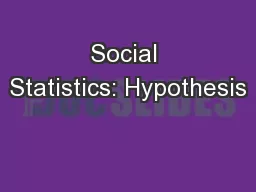

The difference between a sample and a population Null and research hypotheses What is a good hypothesis This week 2 Hypothesis An educated guess Research questions hypothesis A good hypothesis translates a problem or research question into a form that is more amendable to testing ID: 641014
Download Presentation The PPT/PDF document "Social Statistics: Hypothesis" is the property of its rightful owner. Permission is granted to download and print the materials on this web site for personal, non-commercial use only, and to display it on your personal computer provided you do not modify the materials and that you retain all copyright notices contained in the materials. By downloading content from our website, you accept the terms of this agreement.
Slide1
Social Statistics: Hypothesis Slide2
The difference between a sample and a population
Null and research hypothesesWhat is a good hypothesis
This week
2Slide3
Hypothesis
An educated guessResearch questions
hypothesisA good hypothesis translates a problem or research question into a form that is more amendable to testing
Practical way: test your hypothesis in a sample and generalize it to the larger population
What is a hypothesis?
3Slide4
$$$
TimeSampling:
Sample vs. populationSampling errors measure how well a sample approximates the characteristics of a population.
Research and reality
4Slide5
A representative sample
Represent population as close as it canEnsuring the high similarity of both
Time and $$$
Sampling
5Slide6
State the hypothesis
Set decision criteria
Collect data and compute sample statistic
Make a decision (accept/reject)
The Steps of Hypothesis Testing
6Slide7
Assumes
no relationship between two variables that you are going to study
Such as there will be no difference in the average score of 9th
graders and the average score of 12
th graders on the ABC memory test.
There is no difference between white and black families in the amount of assistance offered to their children in school-related activities.
Null hypothesis
7Slide8
A starting point
In the absence of any other information guess?
Benchmark against other outcomes
To compare with other observed outcomes to see if these differences are due to some other factors
Null hypothesis (
)
8Slide9
A definite statement that there is a relationship between variables
Null hypothesis research hypothesis
There is no difference between white and black families in the amount of assistance offered to their children in school-related activities.
There is
a difference
between white and black families in the amount of assistance offered to their children in school-related activities.
Research hypothesis
(
)
9Slide10
Reflects the difference between groups, but the direction of the difference is not specified (such as more than or less than)
Nondirectional research hypothesis
10Slide11
Reflects the difference between groups, and the direction of the difference is specified.
The average score of 12th
graders is greater than the average score of 9th graders on the ABC memory test.
Either
H: X > Y or H: X < Y
Directional research hypothesis
11Slide12
Null hypothesis
Nondirectional
research
hypothesis
Directional
research hypothesisThere is no difference
between the score of the test and the time spending for assignments in the class.
There
is no difference between the consumption of ices cream and crime.
There
is no difference between reading more papers and writing good paper.
There is no differences for the kid’s reading behavior
and kid’s eating habit.
Exercises
12Slide13
Criteria
Stated in a declarative form and not as a questionPosits an expected relationship between variables
Reflects theory or literatureBe brief and to the point
Testable and measureable
Parents who enroll their children in after-school programs will miss fewer days of work in one year and will have a more positive attitude toward work than will parents who do not enroll their children in such programs.
Good hypothesis
13Slide14
It is know that, nationally, doctors working for health maintenance organizations (HMOs) average 13.5 years of experience in their specialties, with a standard deviation of 7.6 years. The executive director of an HMO in a Western state is interested in determining whether or not its doctors have less experience than the national average. A random sample of 150 doctors from HMOs shows a mean of only 10.9 years of experience.
Please state both the research and the null hypotheses for above situation.
Exercises
14Slide15
Take two empirical research articles, find
What is the null hypothesis
What is the research hypothesis
Create your own null and research hypothesis in your interested area.
Evaluate your hypothesis based on the criteria,
What are hypotheses for your group project? Please write a paragraph to summarize.
Exercises
15